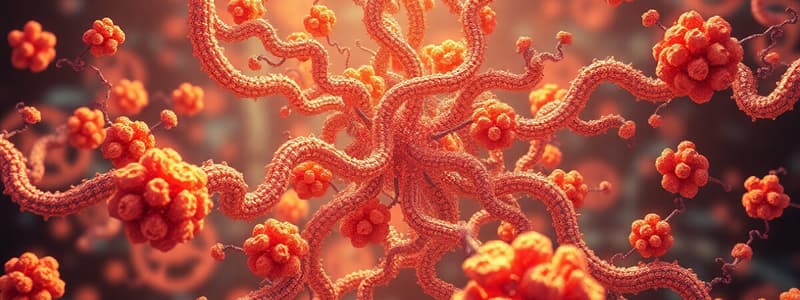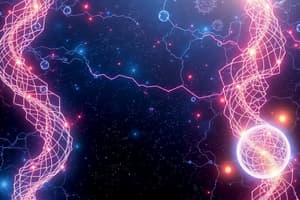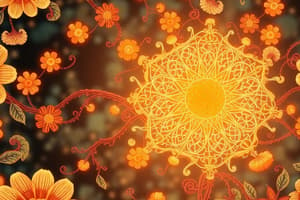Podcast
Questions and Answers
What does the energy difference (ΔG) refer to in bioenergetics?
What does the energy difference (ΔG) refer to in bioenergetics?
- The rate of energy production in a metabolic reaction.
- The difference between the initial and final energy levels of a reaction. (correct)
- The amount of energy released by a metabolic process.
- The efficiency of energy transfer in a biological system.
What is a characteristic of a reaction with a negative ΔG?
What is a characteristic of a reaction with a negative ΔG?
- It is a reversible reaction.
- It occurs spontaneously. (correct)
- It requires energy input to proceed.
- It is an endothermic process.
Which of the following is NOT a way that ATP is produced in biological systems?
Which of the following is NOT a way that ATP is produced in biological systems?
- Deamination (correct)
- Oxidative phosphorylation
- Substrate-level phosphorylation
- Photophosphorylation
What is the primary role of NADH and FADH2 in ATP production?
What is the primary role of NADH and FADH2 in ATP production?
What is the correct sequence of events in the process of glycolysis?
What is the correct sequence of events in the process of glycolysis?
Which of the following statements is TRUE about the pentose phosphate pathway?
Which of the following statements is TRUE about the pentose phosphate pathway?
What is the role of gluconeogenesis in carbohydrate metabolism?
What is the role of gluconeogenesis in carbohydrate metabolism?
Which of the following is a key regulatory enzyme in glycolysis?
Which of the following is a key regulatory enzyme in glycolysis?
Which of the following is NOT a product of the TCA cycle?
Which of the following is NOT a product of the TCA cycle?
What is the role of the electron transport chain in oxidative phosphorylation?
What is the role of the electron transport chain in oxidative phosphorylation?
How does fermentation differ from aerobic respiration?
How does fermentation differ from aerobic respiration?
What is the main function of the TCA cycle in energy metabolism?
What is the main function of the TCA cycle in energy metabolism?
What is the relationship between glycolysis and the TCA cycle?
What is the relationship between glycolysis and the TCA cycle?
Which of the following is a key difference between substrate-level phosphorylation and oxidative phosphorylation?
Which of the following is a key difference between substrate-level phosphorylation and oxidative phosphorylation?
Which of the following processes is primarily responsible for maintaining blood glucose levels during periods of fasting?
Which of the following processes is primarily responsible for maintaining blood glucose levels during periods of fasting?
What is the main role of glycogen in carbohydrate metabolism?
What is the main role of glycogen in carbohydrate metabolism?
What is the primary function of the pentose phosphate pathway?
What is the primary function of the pentose phosphate pathway?
What type of molecule is glycogen classified as?
What type of molecule is glycogen classified as?
In the structure of glycogen, what type of linkages are found in the branched part?
In the structure of glycogen, what type of linkages are found in the branched part?
What is the primary function of glycogen stored in the liver?
What is the primary function of glycogen stored in the liver?
What substance is required to activate glucose 1-phosphate before it can be integrated into glycogen?
What substance is required to activate glucose 1-phosphate before it can be integrated into glycogen?
What is the role of glucose 6-phosphate in metabolism?
What is the role of glucose 6-phosphate in metabolism?
Which of the following products is generated during the oxidative phase of the pentose phosphate pathway?
Which of the following products is generated during the oxidative phase of the pentose phosphate pathway?
Which of the following statements about the non-oxidative reactions of the pentose phosphate pathway is correct?
Which of the following statements about the non-oxidative reactions of the pentose phosphate pathway is correct?
What is the center protein associated with glycogen?
What is the center protein associated with glycogen?
How many protons does 1 NADH pump across the membrane during electron transport?
How many protons does 1 NADH pump across the membrane during electron transport?
Which shuttle converts NADH into FADH2 inside the mitochondria?
Which shuttle converts NADH into FADH2 inside the mitochondria?
What is the total potential ATP yield from 1 mole of glucose during oxidative metabolism?
What is the total potential ATP yield from 1 mole of glucose during oxidative metabolism?
Which of these is NOT a source of blood glucose?
Which of these is NOT a source of blood glucose?
During glycolysis, how many ATP molecules are produced from 1 mole of glucose?
During glycolysis, how many ATP molecules are produced from 1 mole of glucose?
Which enzyme is involved in converting pyruvate into Acetyl-CoA?
Which enzyme is involved in converting pyruvate into Acetyl-CoA?
What alternative pathway can utilize glucose to produce ribose 5-phosphate?
What alternative pathway can utilize glucose to produce ribose 5-phosphate?
What is the function of phosphofructokinase-1 (PFK-1) in carbohydrate metabolism?
What is the function of phosphofructokinase-1 (PFK-1) in carbohydrate metabolism?
Which of the following molecules appears as a result of gluconeogenesis?
Which of the following molecules appears as a result of gluconeogenesis?
Flashcards
What is glycogen?
What is glycogen?
A branched-chain polysaccharide made of alpha-D-glucose units. The linear part of the chain is linked by alpha-1,4 glycosidic bonds, while branches are formed by alpha-1,6 glycosidic bonds. A central protein called glycogenin serves as a core for glycogen synthesis.
What is the primary function of glycogen in skeletal muscle?
What is the primary function of glycogen in skeletal muscle?
Glycogen stored in skeletal muscle is primarily used to provide energy for muscle contraction. It's a local and fast source of glucose 1-phosphate, which can be quickly converted to glucose for energy production.
What is the primary function of glycogen in the liver?
What is the primary function of glycogen in the liver?
The liver stores glycogen as a reservoir for the entire body. It's essential for maintaining blood glucose levels, especially during fasting or between meals.
How is glycogen synthesized?
How is glycogen synthesized?
Signup and view all the flashcards
How is glycogen degraded?
How is glycogen degraded?
Signup and view all the flashcards
What is the main function of the pentose phosphate pathway?
What is the main function of the pentose phosphate pathway?
Signup and view all the flashcards
Describe the oxidative reactions of the pentose phosphate pathway.
Describe the oxidative reactions of the pentose phosphate pathway.
Signup and view all the flashcards
Describe the non-oxidative reactions of the pentose phosphate pathway.
Describe the non-oxidative reactions of the pentose phosphate pathway.
Signup and view all the flashcards
Electron Transport Chain (ETC)
Electron Transport Chain (ETC)
Signup and view all the flashcards
ATP
ATP
Signup and view all the flashcards
Oxidative Phosphorylation
Oxidative Phosphorylation
Signup and view all the flashcards
Pyruvate Dehydrogenase (PDH) Complex
Pyruvate Dehydrogenase (PDH) Complex
Signup and view all the flashcards
Citric Acid Cycle (Krebs Cycle)
Citric Acid Cycle (Krebs Cycle)
Signup and view all the flashcards
Gluconeogenesis
Gluconeogenesis
Signup and view all the flashcards
Glycogenolysis
Glycogenolysis
Signup and view all the flashcards
Glycogenesis
Glycogenesis
Signup and view all the flashcards
Pentose Phosphate Pathway
Pentose Phosphate Pathway
Signup and view all the flashcards
Glycerol 3-Phosphate Shuttle
Glycerol 3-Phosphate Shuttle
Signup and view all the flashcards
What is bioenergetics?
What is bioenergetics?
Signup and view all the flashcards
What does ΔG represent in bioenergetics?
What does ΔG represent in bioenergetics?
Signup and view all the flashcards
What is the primary energy currency in cells?
What is the primary energy currency in cells?
Signup and view all the flashcards
What is substrate-level phosphorylation?
What is substrate-level phosphorylation?
Signup and view all the flashcards
What is oxidative phosphorylation?
What is oxidative phosphorylation?
Signup and view all the flashcards
What is glycolysis?
What is glycolysis?
Signup and view all the flashcards
What is gluconeogenesis?
What is gluconeogenesis?
Signup and view all the flashcards
What is the pentose phosphate pathway?
What is the pentose phosphate pathway?
Signup and view all the flashcards
What is glycogenolysis?
What is glycogenolysis?
Signup and view all the flashcards
What is glycogenesis?
What is glycogenesis?
Signup and view all the flashcards
What is the citric acid cycle?
What is the citric acid cycle?
Signup and view all the flashcards
What is oxidative phosphorylation?
What is oxidative phosphorylation?
Signup and view all the flashcards
What is the electron transport chain?
What is the electron transport chain?
Signup and view all the flashcards
What are NADH and FADH2?
What are NADH and FADH2?
Signup and view all the flashcards
What is pyruvate?
What is pyruvate?
Signup and view all the flashcards
What is Acetyl-CoA?
What is Acetyl-CoA?
Signup and view all the flashcards
Study Notes
Bioenergetics
- Bioenergetics is the transfer and utilization of energy in biological systems
- Bioenergetics predicts if a process is possible, while kinetics measures the reaction rate
- Enzymes cannot create a reaction by themselves
Free Energy
- Free energy (G) measures the energy available to do work in a system.
- A negative change in free energy (ΔG) indicates a spontaneous reaction (exergonic)
- A positive change in free energy (ΔG) indicates a non-spontaneous reaction (endergonic)
- Energy difference (ΔG): (Final E) - (Initial E)
ATP Production
- ATP is the primary energy currency of the cell
- ATP can undergo hydrolysis (breaking down with water), releasing energy
- Substrate-level phosphorylation is a metabolic reaction that involves the direct transfer of a phosphate group to ADP from another phosphorylated substrate.
- Oxidative phosphorylation occurs in the electron transport chain, generating a large number of ATP molecules.
Learning Objectives (Bioenergetics and Carbohydrate Metabolism)
- Describe bioenergetics
- Discuss energetics in metabolic reactions
- List ATP production ways
- List pathways of glucose inside the cell
- Describe glycolysis and gluconeogenesis
- Explain the pentose phosphate pathway
- Describe glycogenolysis and glycogenesis
- Explain the citric acid cycle and electron transport chain
Carbohydrate Metabolism
- Glucose is an important energy source for the body.
- Glycogen is a storage form of glucose in animals.
- Glycolysis is the metabolic pathway that converts glucose into pyruvate.
- Gluconeogenesis is the metabolic pathway that converts non-carbohydrate precursors into glucose.
- Glycogenolysis is the breakdown of glycogen
- Glycogenesis is the formation of glycogen
- Pentose phosphate pathway produces NADPH and Ribose 5-phosphate
Glycolysis
- Glycolysis is the breakdown of glucose into pyruvate, generating ATP and NADH
- Glycolysis occurs in the cytoplasm
- Glycolysis has two stages: investment stage and energy payoff stage.
TCA Cycle (Citric Acid Cycle)
- The TCA cycle is a central metabolic pathway in aerobic respiration
- The TCA cycle is a series of oxidation reactions in the mitochondria.
- Acetyl-CoA enters the TCA cycle and is oxidized.
- The cycle produces carbon dioxide, ATP, NADH, and FADH2.
Oxidative Phosphorylation and ETC
- Oxidative phosphorylation is the process that harnesses energy from NADH and FADH2 to create ATP
- NADH and FADH2 pass electrons to the ETC (electron transport chain).
- The ETC creates a proton gradient that is used to produce ATP.
Fermentation
- Fermentation is an anaerobic process that regenerates NAD+ from NADH, with the production of lactate or ethanol
- Fermentation is used in the absence of oxygen to provide ATP to skeletal muscles.
Pentose Phosphate Pathway
- Pentose phosphate pathway is an alternative pathway for glucose metabolism
- NADPH is created from this pathway
- The pathway gives Ribose 5-phosphate which is used for nucleotide and nucleic acid synthesis.
Hormonal Regulation of Glycolysis
- Insulin supports glycolysis
- Glucagon doesn't support glycolysis.
Glycogen
- Glycogen is a branched polysaccharide storage form of glucose.
- Glycogen is stored in the liver and skeletal muscles.
- Glycogen can be broken down to release glucose rapidly.
Transfer of Cytoplasmic NADH to Mitochondria
- Malate-aspartate shuttle
- Glycerol 3-phosphate shuttle
- NADH produced in the cytosol cannot directly enter the mitochondria. These shuttle mechanisms transport the reducing equivalents for ATP production.
Studying That Suits You
Use AI to generate personalized quizzes and flashcards to suit your learning preferences.




